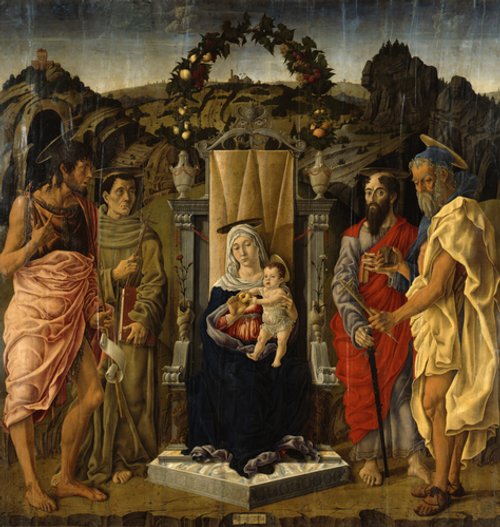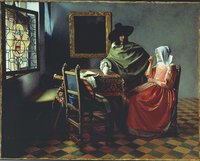Dieses nahezu quadratische Altarbild schmückte ursprünglich den Hauptaltar der Kirche S. Giovanni Battista in Pesaro, die deren Stadtherr Alessandro Sforza hatte erbauen lassen. Konzeptionell entspricht es dem Bildtypus der Sacra conversazione (heilige Unterhaltung): Es zeigt die Jungfrau und das Jesuskind mit vier Heiligen im selben, hier quadratischen Bildraum. Diese Darstellungsweise, eine Modernisierung des seinerzeit weit verbreiteten Polyptychons, war in den 1430er-Jahren von Frau Angelico und Filippo Lippi in Florenz entwickelt worden. Im Veneto fand sie erst ab der zweiten Hälfte des 15. Jahrhunderts Eingang in die Malerei, obwohl Künstler wie Andrea Mantegna und Giovanni Bellini entsprechende Vorstöße unternahmen. Doch es war Marco Zoppo, der mit seiner Thronenden Madonna den entscheidenden Schritt wagte. Der in Cento bei Bologna geborene Zoppo kam Mitte der 1450er-Jahre nach Padua, um unter Francesco Squarcione zu arbeiten, der ein Jahrzehnt zuvor bereits Andrea Mantegnas Lehrer gewesen war. In Padua entwickelte Zoppo einen kalligrafischen, »mineralischen« Stil, der auch diese Tafel prägt: Die Gewänder der Figuren scheinen wie in Bergkristall geschnitten, ebenso wie die Thronornamente, vor allem die mit Wacholderzweigen geschmückten Schalen von Meeresschnecken auf beiden Seiten. Zoppos Signatur im Unterteil des Bildes verweist darauf, dass das Bild in Venedig entstand, der Heimat Giovanni Bellinis. In den hellen Farben und dem reinen Licht, in das die Landschaft im Hintergrund getaucht ist, zeigt sich der Einfluss Bellinis. Sie wurden später zu einem allgemeinen Charakteristikum der venezianischen Malerei. Die Art und Weise, in der Zoppo die Figuren im Vordergrund mit der Landschaft im Hintergrund zu verzahnen sucht, ist bemerkenswert: Die von einer Blumengirlande gerahmte Kirche oberhalb von Marias Thron ist keine andere als S. Giovanni Battista in Pesaro, für die dieses Bild gemalt wurde. Ein Vergleich mit den Werken Giovanni Bellinis zeigt jedoch die Kluft zwischen beiden Künstlern. Auch der junge Bellini entwickelte, inspiriert von Mantegna, zunächst einen sehr mineralischen Stil, von dem er sich löste, als er zu einem eigenen Stil fand. Zoppo jedoch konnte offenbar nicht anders, als alles, was er malte, zu »versteinern«: Die Heiligenscheine schweben über den Köpfen der Dargestellten wie goldene Scheiben, und selbst die Vegetation scheint aus Stein gehauen. Ein paar Jahre nachdem Zoppo sein Altarbild vollendet hatte, erhielt Bellini den Auftrag, für die zweite Franziskanerkirche in Pesaro eine Marienkrönung (Abb. links) zu malen, die das Format und die Verzahnung der Figuren mit der Landschaft aus Zoppos Version aufgriff. Das Verhältnis von Farbe und Licht ist in Bellinis Gemälde viel subtiler ausbalanciert. Wir wissen nicht, ob Zoppo das Werk seines Konkurrenten je zu Gesicht bekam oder ob er seine Niederlage eingestand. Die Gelegenheit für eine Revanche blieb ihm verwehrt, denn er starb 1478 im Alter von nur 45 Jahren.| 200 Meisterwerke der europäischen Malerei - Gemäldegalerie Berlin, 2019 SIGNATUR / INSCHRIFT: MARCO ZOPPO DABOLO/GNIA PINSIT MCCCCLXXI/I(...) VINEXIA ::::::::::::: This altarpiece originally occupied the main altar of the Church of San Giovanni Battista in Pesaro, built by the lord of the place, Alessandro Sforza. Its typolog follows the scheme of the sacra conversazione or “holy conversation”, with the Virgin and Child surrounded by saints represented in the same space, in square format. This type of representation, which modernized the ancient typology of the polyptych, had been invented in Florence in the 1430s by Fra Angelico and Filippo Lippi. In Veneto, painters still hesitated to use it until the second half of the 15th century, even if artists like Andrea Mantegna and Giovanni Bellini made attempts in this direction. But it was Marco Zoppo who proposed a decisive step with this very painting. Born in Cento, near Bologna, Zoppo came to Padua in the mid-1450s to work with Francesco Squarcione, who had been Andrea Mantegna’s master a decade before. There, he developed a style calligraphic and mineral, well visible in the present painting: the draperies of the figures seem to have been cut in a rock crystal, as the ornaments of the throne, to begin with the shells on the sides, containing beautiful juniper flowers. In his signature at the bottom of the picture, Zoppo indicates that he had made this altarpiece in Venice, home of Giovanni Bellini. The taste for transparent colour and pure light, which is clearly seen in the distant landscape surrounding the figures, can be identified as an influence from Bellini and would later become common in Venetian painting. It is interesting to notice how Zoppo tries to link the figures in the foreground to the landscape behind them: the church in the distance, framed by a garland of flowers above the throne of the Virgin, is none other than the church of San Giovanni Battista in Pesaro, for which the altarpiece was painted. A comparison with the work of Giovanni Bellini shows, however, the gap between the two artists. The young Bellini also used to paint in a very mineral style, inspired by Mantegna, before detaching himself from this influence in order to reach a synthesis of his own. Zoppo could not help but continue petrifying everything: the halos on the saints’ heads look like golden plates, while even the vegetation in the landscape seems made of rocks. A few years after Marco Zoppo’s altarpiece, Bellini was asked by the other Franciscan order in Pesaro to paint a Coronation of the Virgin (fig. left) that should take up the unified format and the integration between holy characters and landscape. Here, the balance between colour and light is much subtler than for Zoppo. It is not known whether Zoppo saw Bellini’s work, or whether he admitted his defeat; in any case, he never had the opportunity to ask for revenge, for he died in 1478, at the age of only 45.| 200 Masterpieces of European Painting - Gemäldegalerie Berlin, 2019
de

